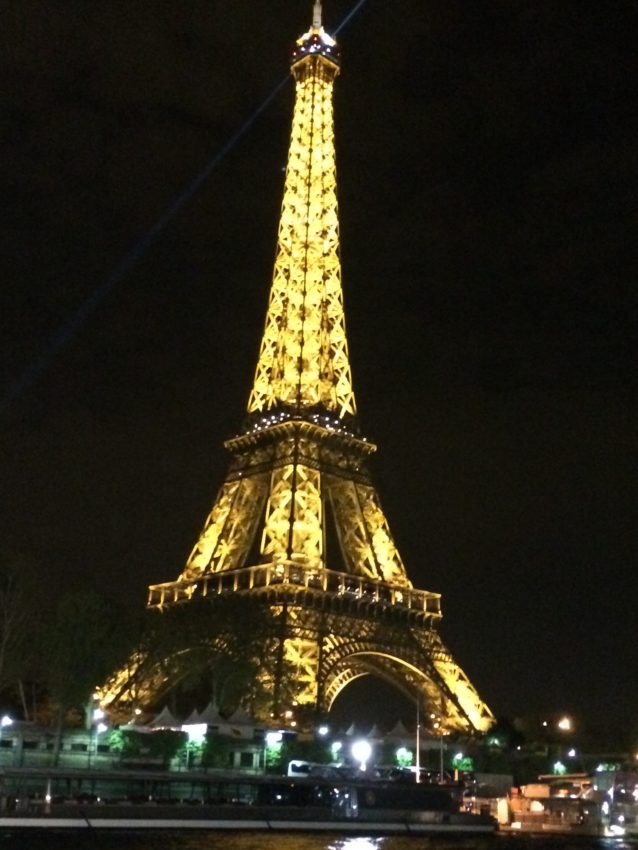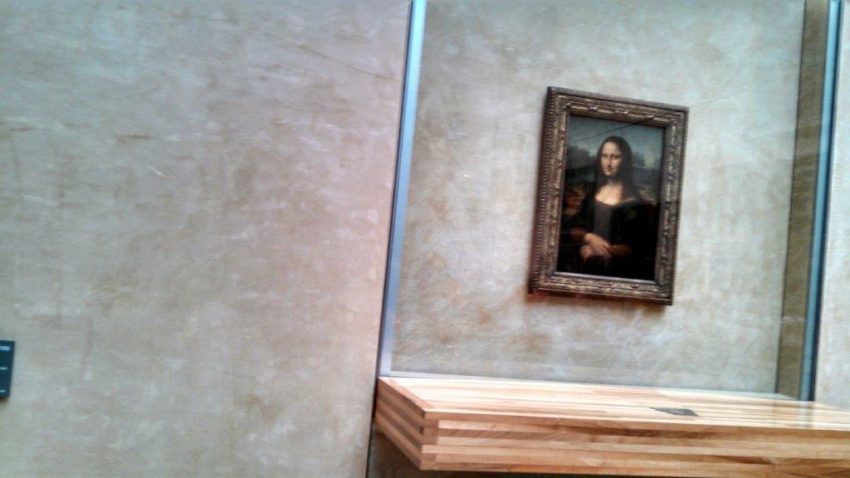Paris in spring means a return trip to the Louvre and a room full of nudes

PARIS — My spring travels have taken me all over the globe but a week in Paris was nearly forced on me by EasyJet, Europe’s discount airline with flights less expensive than a meal in Cedar Rapids, Iowa. I had a December magazine assignment cancel on me and EasyJet, in lieu of a refund, made me transfer my flight. If there’s a better free trip than Paris in spring, let me know. I’ll go.
Covering the Tour de France six times, I know Paris well. However, I’ve never been there when it wasn’t December and dark 16 hours a day or in July when it’s as crowded as the corridors in Fenway Park. Gorgeous 70-degree sunshine greeted me when I landed and I settled into a modest apartment in one of the best locations in the city: the heart of the Latin Quarter. My new iPhone decided to pick Paris to die on me so I decided to play tourist instead of going Charlie Hebdo on the local Apple outlet,
Some experiences in Paris are worth repeating, even with your clothes on. I decided to return to the Louvre for only the second time. I’d gone to the Louvre in 1978 when I was backpacking around the world. I was seeing Paris on $20 a day and stood in a line that snaked through the massive square for three hours. I talked to a young French Canadian couple the entire time. By the time we finally entered I was nearly conversational in French. My first Louvre experience was lousy. I had an afternoon appointment with the Associated Press’ Paris bureau chief, who turned out to be a complete swine, and I was in a hurry. You can’t do the Louvre in a hurry. There are 35,000 works of art spread out on four floors, one of which has a corridor that’s 440 meters long. The Louvre is more for Olympians than the casual art follower.
This time, at least, there was no three-hour wait. Paris in spring is one of the heavenly places on Earth and the amount of tourists is minimal compared to the colossal chaos of summer. The January massacre of the 12 Charlie Hebdo staffers probably didn’t help much, either, although that newspaper’s circulation is creeping up near Le Monde’s. There were only about 15 people in line entering the big glass pyramid that serves as a very artsy security gate. There were only two people in one of the five ticket counters that encircle a round entry hall in the basement.
Seeing the Louvre requires strategy. You must decide what you want to see, not how long you’re going to spend. It’s estimated that it would take one month of daily visits to see every piece of art. The museum map they give you with your ticket is just one fold smaller than my map of China. It covers four floors, each wing color coded to represent one genre. On the ground floor, brown is 5th-18th century French sculpture, yellow is Antique Iran, turquoise is Pharaonic Egypt, blue is Greek Antiquities, etc.
The first floor gets most of the crowds. It’s the location for the Mona Lisa, Napoleon Apartments and some other major masterpieces.
My problem with the Louvre is this: It gets 9 million visitors a year. It’s the most popular museum in the world. There are 173 countries in the world. I’m willing to bet someone from every country visits every month. However, the descriptions are all in French. Except for some brief explanations of the room you enter, everything is for the French visitor. It’s as if the French say … well, I wouldn’t know they’re trying to say. It would be in French.
Since my French knowledge doesn’t go much past a croissant menu, I button hooked back and paid the 5 euro for the audio guide. The audio guide is as complicated as my iPhone. It has instructions on how to turn on the instructions. I had the frazzled audio clerk push the necessary buttons to get to the keypad where you punch in the corresponding numbers of the paintings.
I then returned to my first target: the Napoleon Apartments. I punched in the number on the sign: 274. Nothing. I punched in 0274. Nothing. Since I got nothing from my iPhone that day, I felt like nothing. Instead, I felt like screaming. But yelling my favorite full-pitch wail, “MOTHER FUCK ME!” probably wouldn’t go over well in the world’s most famous museum. Instead, I stormed back to the clerk who told me the numbers are always four numbers, not three.
“I don’t know what the hell you were looking at, you dumb American moron,” she wanted to say. Instead, she said, “Good luck.” Sure enough. Pieces that had four numbers next to headphones had descriptions in the audio guide. The three numbers? They were there just to fuck me.
Anyway, the audio guide doesn’t describe many pieces of art. The woman said, “It’s only the masterpieces. There are too many others.”
So in the three hours I perused the first and ground floors. Here are my highlights. They were high enough to make the visit worth all the frustration, near panic and walking the equivalent of about three miles:
• Napoleon III Apartments: Napoleon never lived in them although as I walked through the huge rooms with masterpieces on the walls and chandeliers on the ceiling, I kept imagining the little prick sitting in an overstuffed high chair with a courtesan on his lap. In actuality, they were named for the artistic style from the Napoleonic Period in the 17th century. The apartments consist of seven rooms connected by a very long corridor. One massive room was used for dances and an opening high by the ceiling held an orchestra once played. The room could also be converted into a theater. The dining room is the size of half a basketball arena. The long table is still set for a party of 40 with three chandeliers illuminating every dish and portraits of famous Frenchmen staring at each guest.
This is where the French royalty lived. It wasn’t always a museum. King Philip Augustus, who transformed France from a small feudal state into Europe’s greatest power in the 13th century, had this giant fortress built on the Seine’s Right Bank between 1190-1202 to ward off invasion. It later became a royal residence whose tenants had their share of escargot in these apartments.
Meanwhile, the French proletariat were eating rats and murdering each other outside these walls until 1793 when the French revolutionaries lopped off Marie Antoinette’s head, among a few others who would never again feel the sensation of a buttered snail crawl down their throat.
When the revolution ended in 1793, the building turned into a museum with a modest collection of only about 2,500 pieces. However, French governments saw the Louvre as a cultural showcase and amassed huge collections inside the building. Soon it became what it is today, the most famous, most overwhelming, most rich museum in the world.

• Crown Jewels of Louis XV: This is not a painting. The Crown Jewels include what is believed to be the largest diamond ever found. It’s 140 carats or slightly larger than a Titleist golf ball. What makes this particular diamond even more remarkable is it’s a perfect shape. It’s perfectly diametrically, the same length up and down as right to left. A French jeweler named Jean-Baptiste Tavernier found it in India — legend has it he stole it from a Hindu idol’s eye — and brought it back to the French crown. Even today, diamond cutters marvel at its perfection.
Sitting behind a glass case, it actually shines a light from each little panel of the diamond. Move to one side and the lights come at you from different angles. It’s like putting your head into a silver kaleidoscope.
Next to it is King XV’s crown, a huge purple bonnet, today adorned with fake jewels. But in front is an indentation where the diamond once laid. I wonder how that went over during parades while Frenchmen were eating stale bread.

• Mona Lisa. I never understood the fascination of the world’s most famous painting. I saw it in 1978, fighting the crowds just to get a glimpse of the famous smile. It’s on the same wall as it was then, hanging about 10 feet behind a roped-off area that keeps the mob of camera-toting tourists from getting close enough to even see Mona’s lipstick.
The audio guide, however, explained what makes it famous. First, it may be the most perfect smile in history. A slight upturn of the lips suggests contentment and joy but not ostentatious, in-your-face, I’m happy-and-you’re not obnoxiousness. Leonardo da Vinci painted it to celebrate the birth of his second child and his new home. Mona Lisa’s expression represented his sheer, unadulterated yet understated joy.
Mona Lisa’s identity has also been a major controversy, adding to the value. The working story is she was a Florentine who married an Italian count. The fact that she is three-quarters turned and smiling suggests she is approachable, friendly. It’s royalty meeting the masses, something that appeals to everyone who has ever set eyes on her. The eyes never leave you. Some say the eyes look at you like no other painting. I stood there with about 100 other people, some not even looking at it. They were too busy taking selfies. But I stared into her eyes and she stared back. The smile made it look as if she wanted to say something. I’m not sure, but I believe Mona Lisa whispered to me, “You’re iPhone is fucked.”
• The Turkish Bath. I like this one merely because I like pictures of rooms filled with naked women. Jean-Auguste-Dominique Ingres painted this in 1862 as the high point of his genre: nudes. Ingres was fascinated by the nude female body and, since he painted it at 82, he made quite a statement for French virility. He painted many naked women into his work but none surpassed The Turkish Bath. It shows about 20 women, all voluptuous — but not fat — with the white, smooth, almost translucent, skin famous of that era. They all are languishing about on long couches, floors and chairs. Some press their cheeks together as if posing for a photograph. Another has her hand firmly around another’s breast. No bathwater is in sight. Ingres merely wanted to celebrate the female body and the relaxation of the 19th century female. The painting is also round, a Renaissance technique that makes the whole painting look more feminine.
I must admit, the Louvre calmed me down. Between a 140-carat diamond, Mona Lisa smiling at me and 18 naked women’s bodies, I forgot about my problems with 21st century technology.
And go back to the 19th century and that Turkish bathhouse.

